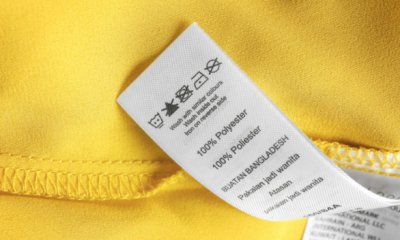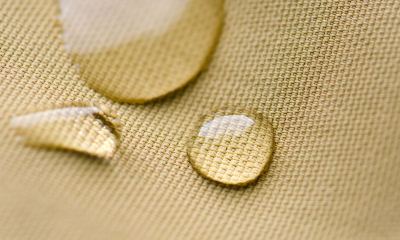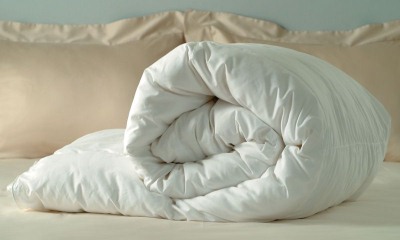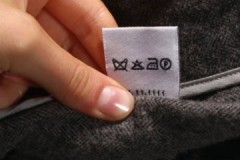Valuable recommendations on how to wash polyester in an automatic machine and by hand
 Things made from polyester are not only comfortable and functional, but also very practical. They do not require particularly careful care.
Things made from polyester are not only comfortable and functional, but also very practical. They do not require particularly careful care.
They can be washed both in a machine and by hand. The main thing is to strictly follow the manufacturer’s recommendations and not expose the fabric to high temperatures.
Read the article about whether and how to wash polyester in a washing machine (in what mode, at what temperature) and by hand, and whether the material shrinks after washing in hot water.
Content
Features of the material
Polyester is one of the most popular synthetic materials. The fabric is created by weaving the main and transverse threads. Externally, polyester resembles wool, but its characteristics are very similar to cotton.
Polyester synthetic fabric is different:
 long service life - not subject to abrasion, mechanical stress, stretching;
long service life - not subject to abrasion, mechanical stress, stretching;- resistance to the absorption of dirt and odors - the special structure of the surface of the fibers does not allow dirt to penetrate and accumulate inside the fabric;
- low creasing - fabric fibers are practically not deformed during washing and drying. Quickly release moisture, forming a smooth surface;
- color fastness - does not fade, tolerates repeated washing, does not fade when exposed to sunlight;
- moisture, wind and cold resistance - the material does not get wet and retains heat well;
- ease of care - if washing recommendations are followed correctly, items made of polyester retain their beautiful appearance for a long time;
- immunity to the effects of aggressive chemicals, the development of bacteria and microorganisms.
How often?
The special specificity of the fiber structure protects the material from rapid contamination. Therefore, it does not need “preventative” washing.
If the item is not very dirty or just has an unpleasant odor, you can freshen it by briefly soaking it and rinsing it in conditioner.
Washing 100% polyester items
Polyester can be washed by hand or in a washing machine.
In the washing machine - on what mode, at what temperature?
Before you start washing polyester items, you need to study the information on the tag. If for a number of reasons the label is missing, or the information on it is not very legible, It is recommended to adhere to the following rules:
-
 Any polyester products must be washed at a temperature not exceeding 40.
Any polyester products must be washed at a temperature not exceeding 40.Fabrics containing polyester fibers are resistant to high temperatures. They may become deformed, lose color, strength, elasticity and shrink.
- To minimize the risk of fabric damage, items must be turned inside out before loading them into the machine.
- You need to choose the most gentle operating mode of the machine - “manual” or “delicate” washing.
- It is preferable to use detergents in liquid form.Regular washing powder is poorly washed out of the fibers. After drying, the product may leave stains and streaks on the surface of the fabric.
- Before washing, polyester items must be sorted. Simultaneous washing of light, colored and dark items is prohibited.
- Do not wash polyester with detergents containing chlorine.
- Air conditioning is required. This will preserve the color of the products, give the fabric additional softness and significantly reduce the likelihood of the fibers accumulating static electricity.
- Fabric spinning is performed only in a gentle mode.
- Drying fabric in the drum of a washing machine is not allowed.
This video will show you how to wash polyester in a washing machine:
Manually
Some polyester items require hand washing only. Such information is always indicated by the manufacturer on the label.
Just like machine washing, hand washing uses water at a temperature not exceeding 40 degrees. The rules of care remain the same:
 take water into a basin and dissolve liquid detergent or powder in it;
take water into a basin and dissolve liquid detergent or powder in it;- things are soaked for 25-35 minutes;
- After soaking, the product is washed with gentle movements. Do not rub or squeeze the fabric too hard to avoid deformation;
- after finishing the washing process, rinse the cleaned item well in plenty of water;
- rinse with conditioner;
- wring things out by lightly squeezing the fabric. Small items can simply be hung on hangers and the water can be allowed to drain on its own.
Nuances for various wardrobe items
Polyester is a universal material used for the manufacture of various types of products.
Coat
Such a large item is best washed in a washing machine (unless otherwise specified by the manufacturer) on a delicate cycle. In this case, a liquid detergent is used that matches the color type of the fabric and a liquid rinse aid. The optimal water temperature is 30.
 To completely eliminate the “powder”, use an additional rinse mode.allowing the fibers to be thoroughly washed. In this case, you need to ensure that the number of spin revolutions is minimal and corresponds to the manufacturer’s recommendations.
To completely eliminate the “powder”, use an additional rinse mode.allowing the fibers to be thoroughly washed. In this case, you need to ensure that the number of spin revolutions is minimal and corresponds to the manufacturer’s recommendations.
When washing by hand, the product is simply soaked in detergent and then rinsed well. Synthetic fibers practically do not accumulate dirt, so there is no need to rub the item too hard. Light squeezing movements will be enough.
Rinse with plenty of water. After washing, the coat is carefully straightened, the water is lightly “dried off” from it by gently pressing the fabric and hung on hangers.
Read about washing coats Here.
Jacket
The care process is similar to washing a coat. Before immersing in the drum of the machine, the jacket must be turned inside out, unfastening all decorative elements from it.
Read more here.
Backpack
The small size of the product allows for both hand and machine washing. Before placing it in a machine drum or hand soaking, all decorative elements are removed from the backpack.
When washing by hand, the backpack is soaked in warm water with soap or detergent solution.Use a soft brush or sponge to remove dirt. After rinsing thoroughly, allow the water to drain. Spinning this type of product is contraindicated.
You can learn about washing a backpack from this section.
Blanket
The blanket can be washed either in a machine, with a capacity of up to 5 kg, or by hand.. In this case, only liquid detergents are used.
 When machine washing, a low temperature of 30-400 and a gentle, delicate cycle are set. Spin is performed at low speed.
When machine washing, a low temperature of 30-400 and a gentle, delicate cycle are set. Spin is performed at low speed.
Hand washing involves soaking for 15-30 minutes in liquid detergent or powder well dissolved in water.
Cleaning the fabric is done using a soft sponge, preventing damage to the surface of the fibers.. Rinsing is performed in several stages.
The clean product is dried in a horizontal position on a smooth surface, alternately changing sides to ensure uniform drying of the blanket.
When washing items with polyester filling in the washing machine It is recommended to place several tennis balls in the drum. This will prevent the material from falling and clumping.
Thermal underwear
To ensure that thermal underwear retains its quality characteristics, both hand and machine washing are done in a delicate mode at a water temperature of no higher than 40. Before putting it in the drum of a washing machine or soaking, items must be turned inside out.
Spinning is carried out in a gentle mode. After thorough rinsing, the products are gently wrung out, but not twisted, and dried away from heat sources and direct sunlight.
Curtains
 Polyester curtains are easy to clean from accumulated dust. They are easy to wash, both by hand and in a machine.
Polyester curtains are easy to clean from accumulated dust. They are easy to wash, both by hand and in a machine.
For hand washing, a weak soap solution or a small amount of powder will be enough. The products can be washed in a machine without adding detergents.
To avoid creases in the fabric, hang the curtains after thorough rinsing., allow the fabric to drain. If necessary, curtains are ironed at a minimum temperature through an additional layer of fabric.
Read about washing curtains here.
How to dry?
A special feature of polyester is the ability of the fibers to quickly get rid of moisture. This material dries very quickly, especially in the fresh air.
When drying naturally, the product is simply laid out on a flat surface or hung on hangers. There is no need to wring things out. It's better to just let the water drain.
As an additional drying agent for small items, you can use a terry towel, which is wrapped around the item and slightly compressed.
Wet items cannot be dried on radiators or radiators. or any other heating devices. This is fraught with the appearance of stains, creases and deterioration of the wear resistance of the fabric.
Is it possible to iron?
In the vast majority of cases, no. Under the right drying conditions, the fabric dries without wrinkles. If necessary, iron polyester items through an additional layer of fabric, setting the temperature as low as possible.
Does it shrink after treatment in hot water?
With proper care, things made of polyester will not shrink. Such a nuisance can only happen in the following cases:
- washing fabrics at high temperatures;
- drying things in a dryer or on heating devices;
- ironing with a very hot iron.
Contraindications for care
In order for the fabric to retain its visual appeal and strength for a long time, it is prohibited:
 boil or wash things at temperatures above 40. High temperatures destroy the structure of the fibers and deform the fabric;
boil or wash things at temperatures above 40. High temperatures destroy the structure of the fibers and deform the fabric;- treat products with harsh detergents containing chlorine, various bleaches or stain removers;
- twist by hand or use high spin speeds when machine washing;
- dry in the sun, hot radiators or other heat sources.
How to remove stains?
Minor surface contamination can be removed using:
- Soap solution. The composition is applied to the area of contamination and the fabric is lightly wiped with a soft sponge, after which it is washed in warm water;
- Salt. Cover the stain with salt and leave for 20-30 minutes. After cleaning, the item is washed and treated with rinse aid;
- Boric acid. To remove stains, use a 10% solution, which is applied in a small amount to the area of fabric at the site of contamination;
- Citric acid. The cleaning solution is prepared in proportions - 1 tsp. citric acid per 200 ml of water. Use the resulting mixture to wipe the contaminated area and rinse the item in cool water before washing.
Conclusion
Polyester is not only very practical and beautiful, but also an easy-care material. Products made from this synthetic fiber are distinguished by their excellent appearance and long service life.
The main thing is to follow the rules of fabric care. Using the washing and drying temperatures specified by the manufacturer will allow you to enjoy your favorite clothes, linen or accessories for many years.


